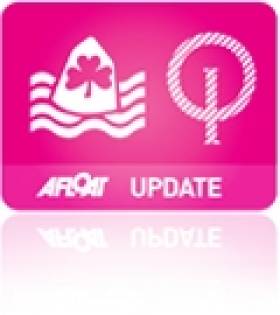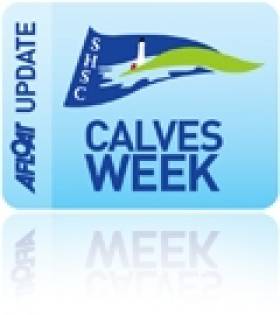Displaying items by tag: Baltimore Sailing Club
Optimist Sailors Arrive for Baltimore Sailing Club Spring Clinic
#optimist – 150 Optimist sailors, with boats and parents in tow, are converging on Baltimore Sailing Club in West Cork today for what looks to be the largest turn out to date for the annual Optimist Spring training clinic.
Sailors from seven to fifteen years of age will sail in a range of groups, from the pre-regatta groups for those just starting out on their sailing career, to sailors who compete internationally as part of the Irish Optimist squad.
Traditionally, the week's coaching is provided by the best of coaches, and this year will be no different, with a mix of top Irish and international coaches arriving to give sailors a kickstart to the 2013 season.
There is a range of activities arranged, both on and off the water, including a fitness camp for children who are not sailing, a mid-week disco, and the traditional forum for parents and the Optimist Association (IODAI).
O'Leary Adds 1720 National Title to Season Haul
Commodore's Cup Captain Anthony O'Leary led the 1720 National Championships from start to finish at Baltimore SC this weekend. He finished the seven race series with four first places. The full results are HERE. There was drama this afternoon when a competitor in the 18-boat fleet was rescued by Baltimore lifeboat. Lifeboat report of the incident HERE
Coveney's Comprehensive Victory at Baltimore Regatta
A light westerly breeze of eight to ten knots arrived in time for the start of Baltimore regatta on Bank holiday Monday. Race Officer Neil Prendeville sent the various fleets on a course through the Gascanane Sound and around the Calve Islands. The inclusion of the Amelia Buoy as a windward mark caused the race officers some anxious moments when the Irish Lights vessel 'Granuaile' lifted the mark during a routine maintenance operation just as the fleet appeared south of the Calves. However, the slow progress of the racing yachts allowed enough time to complete the operation, and the resulting spinnaker run back to Baltimore created a spectacular colourful background in Roaring Water Bay.
In Class Zero IRC Northern Ireland entry 'Crackerjack' scored her first victory of the regatta when owner L.J. Mc Mahon claimed the Regatta Cup. In Echo a fully crewed 'Loco' gave Schull Commodore Morgan O' Donovan the first local win of the regatta..
In Class One IRC Simon Coveney's 'Wavetrain' had a comprehensive victory over Ian Nagle's 'Jelly Baby'while in Echo Donal O'Leary's 'D Tox' took the spoils.
In Class Two IRC Conor Ronan's Corby 26 'Ruthless' had thirteen seconds to spare over Bad Company, while in Echo the Dann/Murphy duo in 'Val Kriss' had an equally narrow victory over the Appelbe family in 'Cochise'.
In Class Three IRC David Keneficks 'Tiger'held off a strong challenge from Cove sailing Clubs 'Bedlam',while in Echo victory went to long time event supporter Padraig O'Donovan of KYC sailing 'Chameleon'.
In Class Four the Hanley brothers in 'Saoirse' claimed victory in both divisions ahead of "Chinook" in IRC and Tete-A-Tete in Echo.
In a highly competitive White Sail One class Frank Whelans 'Blow Wind Blow' had a comfortable win over Donal Heffernans 'Aisling', while in White Sail Two the trophies went to local boats with Kieran Dwyer's 'Brazen Huzie' snatching victory from Dave Waters' 'Genevieve'.
Victory in the large 1720 class went to 'Smile'n Wave' ahead of 'Malarky' and Two to Tango.
Baltimore Sailing Club
Baltimore Sailing Club was founded in 1956 as a summer sailing club. From its inception it has been successfully developing leisure and competitive sailing in Baltimore Harbour. The Club over the years has continued to expand and teach safe sailing skills to young people from all backgrounds. With a function room, kitchen and bar it is very active in the summer months running sailing events, courses and many social activities.
Situated in West Cork on the edge of Roaringwater Bay. The clubhouse is on the pier and close to all facilities. Baltimore Harbour is a busy fishing village all year around with a regular ferry service to the many islands.
Baltimore is also a RNLI community with the local lifeboat house in the village. Many local people give freely of their time and energy to help make our coastal waters safer for all mariners. All crewmembers automatically become honorary members of Baltimore Sailing Club.
Baltimore is a sheltered harbour and a favourite spot for many Irish sailors and foreign cruising boats. There are excellent facilities, a pontoon to tie up at, or one may anchor off. There are some fine restaurants and pubs.
Within Roaringwater Bay there are numerous places to sail to. The famous Fastnet Rock Lighthouse is 14 miles out from Baltimore. Cape Clear Island with a lovely small harbour is the most southerly island off Ireland. Schull and Crookhaven are within in easy reach for the cruising person. Sherkin Island across the bay from Baltimore has a fine pier and a pontoon, belonging to the Island's hotel. For smaller boats there are many islands some uninhabited which have beautiful coves and some sandy beaches to day sail to.
The highlight of the summer season is the Baltimore Regatta always held on the 1st Monday in August. There are many activities and yachts converge on the harbour for a race out around the Islands. These yachts then partake in a week of regattas aroun Roaringwater Bay, now known as Calves Week.
History – The following are extracts from archives, compiled by Richard Perry, courtesy of the Baltimore Club website
The club premises had originally started in Salters Shed in the Harbour and was gradually added to.
The exact year of the foundation of Baltimore Sailing Club is somewhat uncertain! Above the bar, in the Club House, is the formal list of Commodores starting in 1952. In a letter, dated 3rd August 1976, Frank Murphy, who was the first Secretary of the club, stated that the club was founded in the summer of 1953. The Minutes of a Meeting held at Messrs Salters Baltimore on Saturday 28th July 1956 state that "It was unanimously felt that a Sailing Club should be formed.
Present were Thomas Fuller, Davis Wolfe, Hugh Musgrave, Ivo Kennedy, Robin Atkins, Alan Marten and Frank Murphy. At that meeting, on the proposal of Mr Musgrave, seconded by Mr Murphy, Mr Thomas Fuller was elected Commodore and on the proposal of Mr. Fuller, seconded by Mr Musgrave, Mr Frank Murphy was elected Secretary
The following Committee was appointed, which would also act as Sailing Committee: Commodore, Secretary, Robin Atkins and Pip Marten. Baltimore Sailing Club appeared to be the most suitable name but it was decided to withold a decision on this until the next meeting". So there are three years with a claim to be the start date!
There is no doubt that there was dinghy sailing before 1953, first at Tragumna and then at Baltimore and since the official list of Commodores starts in 1952, this should be the start year. It also enables us to celebrate the 50th Anniversary of the Club in 2002! Those who contest this can organise celebrations in 2003 and 2006!
The most interesting account of the founding of the Baltimore Sailing Club is contained in a letter from Frank Murphy to John Newenham (Commodore 1976) dated 3rd August 1976 from which I quote:
"You asked me about Tom and the foundation of the Club. The real background is not generally known. Tom was always deeply concerned at the emigration from Baltimore and Skibbereen and spent much time and money here and abroad, and over a long period, in attempts to establish industries to give employment, but without success. I went with him in one of these efforts which took us to Zurich in 1952. Eventually we discussed expanding and developing the indigenous industry of boat building and promoting Baltimore and the islands as a resort for centreboard sailing which would also benefit local tourism.The first step was to get the people who came there "doing it". Apart from a few motor boats there was only an International 12', one unclassified 12' and an old 2.1/2 ton yacht.
There were increasing numbers of young people both local and summer visitors who could be interested and taught to sail; to start a club was an obvious necessity. I wanted to push on with it but Tom was against doing so until we could be sure of more support. In the early summer of 1953 two more International 12's arrived; in the week following a third was bought in Crosshaven and, when I called to Tom on the Saturday, he had already heard all and declared we start the club immediately and was passing the news all around for a meeting that night, which was duly held in Salter's Lounge (now Bushe's Bar).
He was elected Commodore, and henceforth he and Olive gave it most of their spare time, winter and summer. For years they never missed a weekend on the pier, in fact I only remember one absence in all their years of office when they had to attend the funeral of a relative in England."
Tom Fuller remained Commodore of the Club until 1966. His successor was Frank Murphy who held the position for a year, followed by Hugh Musgrave for two years. Since then the post has been held 17 Commodores, changing approximately every two years. Above all Baltimore Sailing Club was a family club run on a completely voluntary basis. Today many of the children and grandchildren of the founding families are most active participants. There are a total of approximately 200 members.
Undoubtedly the events which put Baltimore on the Sailing Map of Ireland were the Dinghy Weeks. The first one was held in 1960 and was a huge success. By 1969 the Dinghy Week fleet had risen to 250 boats! In the early days Pip Marten was oustanding in that he would turn his hand to absolutely anything which needed to be repaired or done.
He was a good friend of Tom Fuller and a great help to him. Pip was Treasurer for several years. He now lives in Wisborough Green in Sussex and remembers the early days of the club very well. The dinghy weeks were great events. Reg Fraser (Marys Murphy's uncle) illuminated the village, castle and church with flood lights. There was a huge amount of work for the Dinghy Weeks. The Ladies Committee had their own bank account from which all the catering was done. They went out for quotes for a whole range of foodstuffs and kitchen equipment well before the event.
In the early days, starts were in the cove between the Rocket House next to the Baltimore House Hotel (now the Field's residence) and a car parked on the grass opposite on Coney Island (now tree covered) in which Olive Fuller sat and beeped the horn. As the fleet grew the start was moved to Fishery Point.
Baltimore Sailing Club, Baltimore, West Cork. Email: [email protected]
About Baltimore Sailing Club
· Situated in West Cork, the village of Baltimore is just outside Skibbereen.
· Baltimore Sailing Club was founded 1952 and is located on the pier in Baltimore.
· Run by a voluntary committee drawn from local and visiting members.
· 300 members (local and international)
· Current Commodore: Joan Collins from Baltimore.
· From its inception the Club has been successfully developing leisure and competitive sailing in Baltimore Harbour and has continued to expand and teach safe sailing skills to young people from all backgrounds. With a function room, kitchen and bar it is very active in the summer months running sailing events, courses and many social activities.
· Baltimore Harbour is a busy fishing village all year around with a regular ferry service to the many islands.
2014 – New Clubhouse project
The project was seen through to fruition under the leadership of former Commodore, Tony O'Driscoll and his team of volunteers.
Architect:
John McCarthy of McCarthy O'Brien Architects – Dublin/Baltimore.
Builder:
Mikey Joe Leonard – Baltimore.
Works carried out:
· The existing shower rooms which were both cramped and substandard were replaced by a new larger shower block adjoining the existing building. This allowed for the original shower room areas to be adapted as additional teaching/meeting/social space within the main building and replace the marquee previously used to accommodate functions and events.
· New permanent storage facilities now also replace the previous portakabin store.
· The removal of these temporary structures in turn improves dinghy parking facilities.
· Urgent remedial works including replacement of the corrugated iron roof and rewiring were also carried out.
· Materials included white render finish, iroko timber cladding, aluclad windows and zinc cladding to the roofs as appropriate to the prominent location in the village harbour setting.
· Solar collectors are located on the south facing roof of the changing rooms to provide hot water and some underfloor heating to the changing rooms.
· The works commenced in September 2013 and despite the severe weather conditions at the beginning of the year were sufficiently complete to accommodate the Laser Dinghy Munster Championships, a large sailing event in Easter 2014.































































